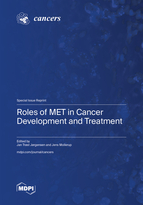Roles of MET in Cancer Development and Treatment
A special issue of Cancers (ISSN 2072-6694). This special issue belongs to the section "Cancer Therapy".
Deadline for manuscript submissions: closed (31 May 2023) | Viewed by 33825
Special Issue Editors
Interests: oncology; predictive biomarkers; companion diagnostics; drug-diagnostic codevelopment; targeted therapy; precision medicine
Special Issue Information
Dear Colleagues,
The therapeutic strategy of targeting oncogenic drivers has changed the treatment landscape for several cancers in the last couple of decades. MET, the hepatocyte growth factor receptor, is considered an important biomarker and a relevant clinical target for therapeutic intervention. MET and its connected signaling pathways have been shown to promote cancer and metastasis and have been linked to the maintenance of cancer stem cells. The targeting of MET in combination with additional therapies is likely to provide synergistic effects that overcome acquired drug resistance and prevent immune escape due to its impact on the tumor microenvironment. The detection of aberrant MET in the form of amplifications, mutations and rearrangements in tumor cells is not trivial, and standardization is a requirement for meaningful decision making to guide treatment. In this Special Issue, we would be happy to welcome contributions in the form of original research, reviews or perspective articles that shed light on the role and detection of MET in cancer, as well as new therapeutic opportunities related to MET.
Dr. Jan Trøst Jørgensen
Dr. Jens Mollerup
Guest Editors
Manuscript Submission Information
Manuscripts should be submitted online at www.mdpi.com by registering and logging in to this website. Once you are registered, click here to go to the submission form. Manuscripts can be submitted until the deadline. All submissions that pass pre-check are peer-reviewed. Accepted papers will be published continuously in the journal (as soon as accepted) and will be listed together on the special issue website. Research articles, review articles as well as short communications are invited. For planned papers, a title and short abstract (about 100 words) can be sent to the Editorial Office for announcement on this website.
Submitted manuscripts should not have been published previously, nor be under consideration for publication elsewhere (except conference proceedings papers). All manuscripts are thoroughly refereed through a single-blind peer-review process. A guide for authors and other relevant information for submission of manuscripts is available on the Instructions for Authors page. Cancers is an international peer-reviewed open access semimonthly journal published by MDPI.
Please visit the Instructions for Authors page before submitting a manuscript. The Article Processing Charge (APC) for publication in this open access journal is 2900 CHF (Swiss Francs). Submitted papers should be well formatted and use good English. Authors may use MDPI's English editing service prior to publication or during author revisions.
Keywords
- MET biology
- MET amplification
- MET mutation
- MET rearrangement
- MET overexpression
- cancer
- MET diagnostics
- prognostic biomarkers
- predictive biomarkers
- companion diagnostics
- MET-targeted therapy
- tumor microenvironment
- diagnostic standardization








